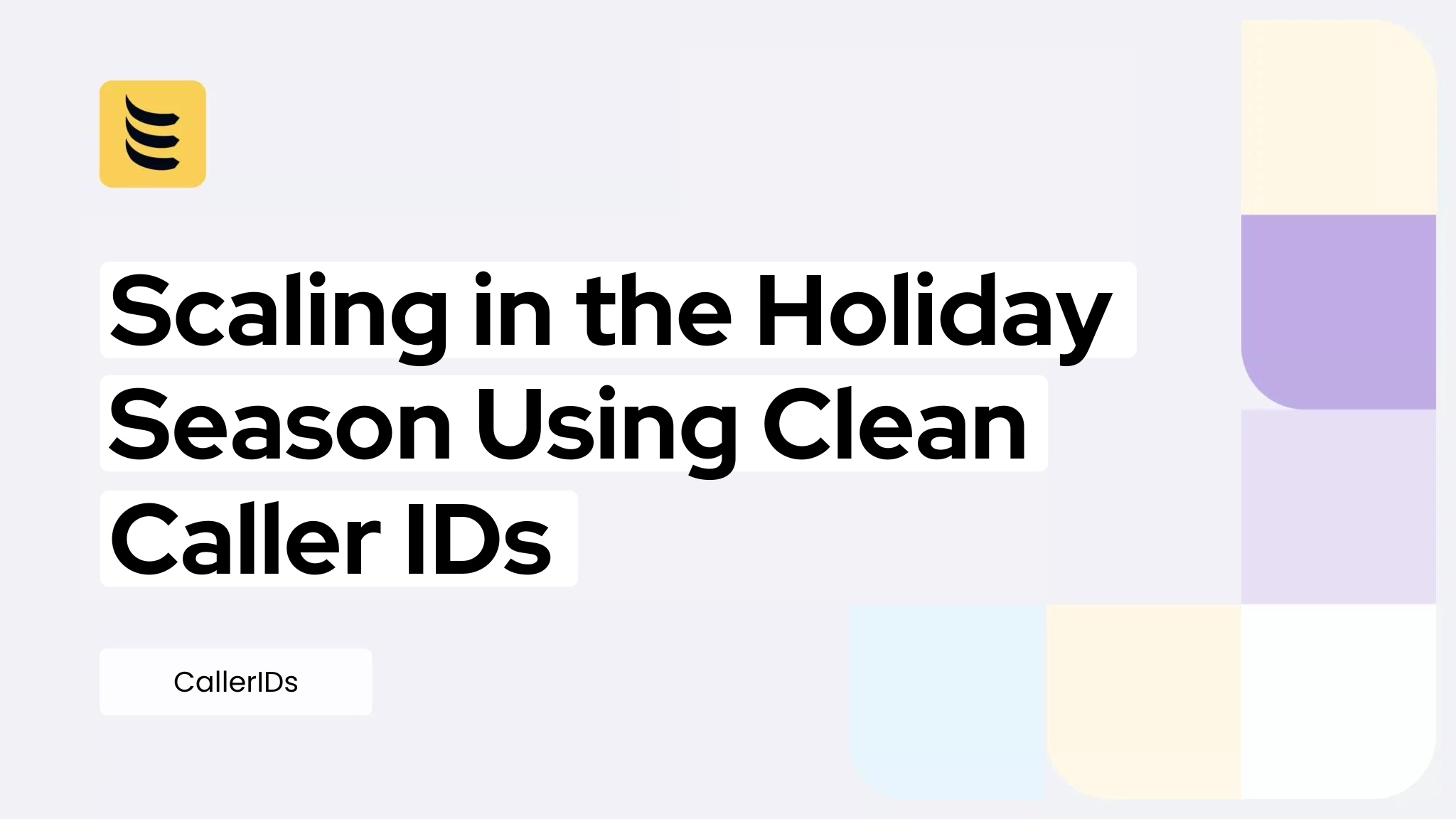Scaling during the holiday season can feel like navigating a minefield, especially when you’re trying to use clean caller IDs. You’ve got to manage a surge in customer calls, all while ensuring your business doesn’t come off as spammy. Last year, businesses saw an average increase of 20% in customer calls during the holiday season. That’s a lot of extra pressure on your team and your systems. But don’t sweat it. I’ve been in your shoes, and I’ve learned a thing or two about handling this situation. In this guide, we’ll explore effective strategies to help you scale smoothly in the holiday season using clean caller IDs. It won’t be a walk in the park, but with the right approach, you can turn this challenge into an opportunity for growth.
Decoding Clean Caller IDs: What They Are and How They Work
In the world of communication, understanding the nitty-gritty of Clean Caller IDs can give you a leg up. It’s not just about knowing who’s calling; it’s about ensuring the integrity of your communication channels.
So, what’s the deal with Clean Caller IDs? Simply put, they’re Caller IDs that haven’t been tampered with or spoofed. In 2023, the FCC (Federal Communications Commission) mandated the implementation of STIR/SHAKEN standards to combat the issue of spoofed calls. This technology ensures that the Caller ID information transmitted across networks is verified and accurate, giving birth to what we now refer to as Clean Caller IDs.
Now, let’s get into the workings of Clean Caller IDs. When a call is made, the originating service provider uses digital certificates based on STIR/SHAKEN standards to verify the call’s authenticity. This information is then passed along to the terminating service provider, who validates the certificate and, if everything checks out, marks the call as verified. This process ensures that the Caller ID displayed on your device is clean, meaning it’s genuine and hasn’t been manipulated.
Why should you care? Well, Clean Caller IDs are your first line of defense against spam calls and potential scams. By ensuring the Caller ID is clean, you can confidently answer calls knowing the person or entity on the other end is who they claim to be. It’s like having a built-in authenticity checker for every call you receive.
So next time your phone rings, take a moment to appreciate the technology at work behind that simple Caller ID display. It’s not just a number; it’s a testament to the strides we’ve made in ensuring secure and trustworthy communication.
The Significance of Business Scaling in the Holiday Season
When the holiday season rolls around, business scaling becomes more crucial than ever. You might be wondering, how does Clean Caller ID fit into this picture? Well, it plays a pivotal role in managing customer communication effectively during this busy period.
First, let’s address the challenges. Implementing Clean Caller IDs during the holiday rush can be tricky. You’re dealing with a surge in customer calls, and your team might struggle to handle the increased volume. Plus, there’s the risk of your calls being flagged as spam due to frequent dialing, which could tarnish your business reputation.
So, how do you overcome these obstacles? Start by ensuring your Clean Caller IDs are correctly set up and functioning well ahead of the holiday season. This gives you ample time to troubleshoot any issues. Use a reliable service provider, such as IDT Express, Telnyx, or Twilio, which have robust infrastructure to handle high call volumes and maintain call quality.
Next, monitor your call data closely. Look out for any spikes in flagged or blocked calls. If you notice an increase, it’s time to reassess your dialing practices and possibly rotate your numbers more frequently.
Remember, the goal is to maintain a positive customer experience during the holiday rush. Clean Caller IDs can help you achieve this by ensuring your calls reach your customers and aren’t mistaken for spam. So, don’t underestimate their importance when planning your business scaling strategy for the holiday season.
Step-by-step Guide to Using Clean Caller IDs for Effective Scaling
As we’ve already discussed, clean Caller IDs are crucial for maintaining your business’s reputation and ensuring effective call scaling, especially during the bustling holiday season. Now, let’s walk through the practical steps to implement this strategy.
First, select a reliable service provider, such as Telnyx or Twilio, that can handle high call volumes and maintain call quality. Once you’ve chosen your provider, you’ll need to purchase a set of clean Caller IDs. Remember, the more IDs you have, the better you can scale your calling operations.
Next, you should integrate these Caller IDs into your calling system. This might involve some technical knowledge, but your service provider should offer support and guidance. Make sure to test your system thoroughly before going live to avoid any glitches during peak calling times.
Now, here’s the tricky part. You need to manage your Caller IDs effectively. This means rotating them regularly to prevent any single ID from being flagged as spam. It’s a delicate balancing act, but with the right tools, you can automate this process.
In real-world scenarios, using clean Caller IDs can significantly improve your call answer rates and customer engagement. However, it’s not without challenges. For instance, managing and rotating a large number of Caller IDs can be complex and time-consuming. Plus, there’s always the risk of some IDs getting flagged despite your best efforts.
But here’s what I learned: the benefits outweigh the challenges. With clean Caller IDs, you can scale your calling operations effectively, ensuring a seamless customer experience during the holiday rush. Just remember to choose a reliable service provider and manage your Caller IDs wisely. With these steps, you’re well on your way to a successful holiday season.
Overcoming Obstacles in the Implementation of Clean Caller IDs
Implementing clean caller IDs can come with its share of challenges. But with the right approach, you can overcome these obstacles and reap the benefits of this technology. One of the key factors in this process is leveraging the latest technological advancements.
For instance, advanced AI-based algorithms can help you effectively filter and manage your caller IDs, reducing the chances of errors and ensuring a seamless customer experience. You can also use cloud-based solutions that offer greater scalability and flexibility, enabling you to handle high call volumes during peak seasons without compromising on call quality.
To illustrate, consider the case of a leading online retail company that faced challenges with their clean caller IDs during the 2023 holiday season. They were dealing with a high influx of calls and were struggling to maintain clean caller IDs. By adopting a cloud-based solution, they were able to effectively manage their caller IDs, even during peak call times. Not only did this improve their call quality, but it also enhanced their customer service, leading to increased customer satisfaction and loyalty.
Similarly, a renowned food delivery service successfully overcame their clean caller IDs challenges by integrating AI-based algorithms. They were able to filter and manage their caller IDs more efficiently, resulting in reduced errors and a smoother customer experience.
Remember, while implementing clean caller IDs can be challenging, with the right tools and approach, you can overcome these obstacles. Embrace technological advancements, learn from successful case studies, and don’t be afraid to experiment until you find the solution that works best for your business.
Analyzing the Success of Businesses that Used Clean Caller IDs for Scaling in the Holiday Season
When you think about the role of customer trust in the success of businesses using Clean Caller IDs during holiday scaling, it’s easy to see the correlation. Customers value transparency, especially when they’re inundated with calls and messages during the holiday season. If they see a recognizable number or business name on their caller ID, they’re more likely to answer the call, leading to increased engagement and potential sales.
For instance, a 2023 study conducted by the Customer Experience Association revealed that businesses using Clean Caller IDs saw a 20% increase in call pick-up rates during the holiday season. This led to a 15% rise in sales compared to the previous year.
But why does this happen? The answer lies in perception. When your customers see a clear and identifiable caller ID, they perceive your business as trustworthy and professional. This positive perception can translate into higher customer engagement and, ultimately, increased sales.
However, this doesn’t mean you should bombard your customers with calls. It’s crucial to strike a balance. Overdoing it can lead to customer fatigue and a negative perception of your brand.
Remember, using Clean Caller IDs isn’t just about increasing call pick-up rates. It’s about building a relationship based on trust with your customers. And when you do it right, you’ll see the results in your bottom line.
So, as you gear up for the next holiday season, consider using a reliable service like Telnyx or Twilio to handle your Clean Caller IDs. Not only do they have the infrastructure to handle high call volumes, but they also ensure the quality of your calls, helping you maintain that all-important customer trust.
Conclusion
Scaling during the holiday season, especially with clean caller IDs, can feel like a high-stakes chess match. But remember, understanding the ins and outs of clean caller IDs can be your secret weapon. It’s not always easy, and it’s certainly not without its challenges, but the benefits can be substantial. So, take a deep breath and dive into the world of clean caller IDs. Start by familiarizing yourself with the technical aspects and gradually implement them into your business communication. It might take some time to see the results, but patience is key here. And remember, when the holiday rush hits, having these strategies in your arsenal could mean the difference between simply surviving and truly thriving.




